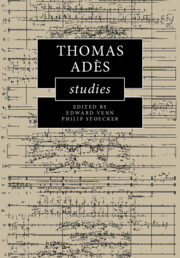Book contents
- Thomas Adès Studies
- Thomas Adès Studies
- Copyright page
- Dedication
- Contents
- Figures
- Tables
- Music Examples
- Online Materials
- Contributors
- Preface
- Acknowledgements
- Notes on the Text
- 1 ‘Chronically volatile’
- 2 Performing Adès
- 3 ‘Fountain of Youth’, ‘River of Meaning’
- 4 ‘Oh brave new Caliban’
- 5 Chaconnes in the Music of Adès
- 6 Closing the Circle?
- 7 A World in Constant Motion
- 8 Musique automatique? Adèsian Automata and the Logic of Disjuncture
- 9 Narrating the Dance of Death
- 10 Hearing Voices in Adès’s Operas
- 11 The RICH Logic of Adès’s The Exterminating Angel and The Tempest
- 12 Sonic Allegory in Adès’s The Exterminating Angel
- Bibliography
- Index
2 - Performing Adès
Published online by Cambridge University Press: 18 November 2021
- Thomas Adès Studies
- Thomas Adès Studies
- Copyright page
- Dedication
- Contents
- Figures
- Tables
- Music Examples
- Online Materials
- Contributors
- Preface
- Acknowledgements
- Notes on the Text
- 1 ‘Chronically volatile’
- 2 Performing Adès
- 3 ‘Fountain of Youth’, ‘River of Meaning’
- 4 ‘Oh brave new Caliban’
- 5 Chaconnes in the Music of Adès
- 6 Closing the Circle?
- 7 A World in Constant Motion
- 8 Musique automatique? Adèsian Automata and the Logic of Disjuncture
- 9 Narrating the Dance of Death
- 10 Hearing Voices in Adès’s Operas
- 11 The RICH Logic of Adès’s The Exterminating Angel and The Tempest
- 12 Sonic Allegory in Adès’s The Exterminating Angel
- Bibliography
- Index
Summary
Although Adès scholarship has made significant inroads towards understanding the analytical and interpretative richness of his music, the actual sound of it, and the range of meanings a performer might tease from it, have barely begun to be addressed. In this chapter I propose ways in which musical structure in Adès’s music might be reconceived in response to performance. Adès’s own analytical and recorded accounts of Janáček’s ‘In memoriam’ are used to provide preliminary theoretical and methodological orientation, after which I examine Adès’s Mazurkas Op. 27 to consider the dynamic interaction between structures, genres and performance traditions in recordings by multiple pianists. Finally, I turn to recordings of Darknesse Visible to consider the role performance can play in rethinking the relationship of expression and structure in Adès’s music. Underpinning both accounts is a sense of how performances can access the temporal experience of how time passes in Adès’s music.
Keywords
- Type
- Chapter
- Information
- Thomas Adès Studies , pp. 27 - 51Publisher: Cambridge University PressPrint publication year: 2021

